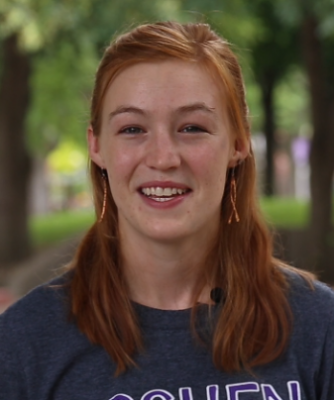
By Ellen Conrad, a senior environmental science major from Lakewood, Colorado
Scripture: John 20:1-18 (NRSV)
After just discovering the stone rolled away from Jesus’s tomb and the bandages with no body, Mary Magdalene must have felt absolutely overwhelmed with emotion. Horrified, grieved and confused, her mind must have been racing to try and explain the inexplicable, questioning everything. How did the stone move? Where was the body? How could this happen? When the angels spoke to her within the tomb, she laments at Jesus’s absent body, too lost in her state to despair to register that she was talking to angels. Too lost in despair to register that the gardener by her side is none other than the last person she was expecting to see—the radiant figure of Jesus. It was she that was the first to receive the news: Jesus is alive again. Rabbouni. Teacher.
Perhaps it was Mary’s willingness to stay at the tomb and grieve or only by pure coincidence that Mary was first to witness Jesus’s resurrection. Mary—a woman of color with little cultural value—seems like the least likely person to be chosen first for such an honor. Shouldn’t it be a prominent leader or a powerful king? True to Jesus’s style in his mortal life, it wasn’t the rich and powerful who were first in the kingdom of heaven, nor the first to receive the news of his resurrection. It was Mary.
The powerful are not chosen first. It is the marginalized—whether that is by class, race, gender, sexual orientation, age, ability or any multitude of factors—that are often in the position of spreading the Jesus’s message to all people. The other disciples would see Jesus themselves later that evening, but when Mary was telling them her message and spreading the word, were they able to listen?
Scripture: John 20:1-18 (NRSV)
Early on the first day of the week, while it was still dark, Mary Magdalene came to the tomb and saw that the stone had been removed from the tomb. 2So she ran and went to Simon Peter and the other disciple, the one whom Jesus loved, and said to them, “They have taken the Lord out of the tomb, and we do not know where they have laid him.” 3Then Peter and the other disciple set out and went toward the tomb. 4The two were running together, but the other disciple outran Peter and reached the tomb first. 5He bent down to look in and saw the linen wrappings lying there, but he did not go in. 6Then Simon Peter came, following him, and went into the tomb. He saw the linen wrappings lying there, 7and the cloth that had been on Jesus’ head, not lying with the linen wrappings but rolled up in a place by itself. 8Then the other disciple, who reached the tomb first, also went in, and he saw and believed; 9for as yet they did not understand the scripture, that he must rise from the dead. 10Then the disciples returned to their homes.
11But Mary stood weeping outside the tomb. As she wept, she bent over to look into the tomb; 12and she saw two angels in white, sitting where the body of Jesus had been lying, one at the head and the other at the feet. 13They said to her, “Woman, why are you weeping?” She said to them, “They have taken away my Lord, and I do not know where they have laid him.” 14When she had said this, she turned around and saw Jesus standing there, but she did not know that it was Jesus. 15Jesus said to her, “Woman, why are you weeping? Whom are you looking for?” Supposing him to be the gardener, she said to him, “Sir, if you have carried him away, tell me where you have laid him, and I will take him away.” 16Jesus said to her, “Mary!” She turned and said to him in Hebrew, “Rabbouni!” (which means Teacher). 17Jesus said to her, “Do not hold on to me, because I have not yet ascended to the Father. But go to my brothers and say to them, ‘I am ascending to my Father and your Father, to my God and your God.’” 18Mary Magdalene went and announced to the disciples, “I have seen the Lord”; and she told them that he had said these things to her.




